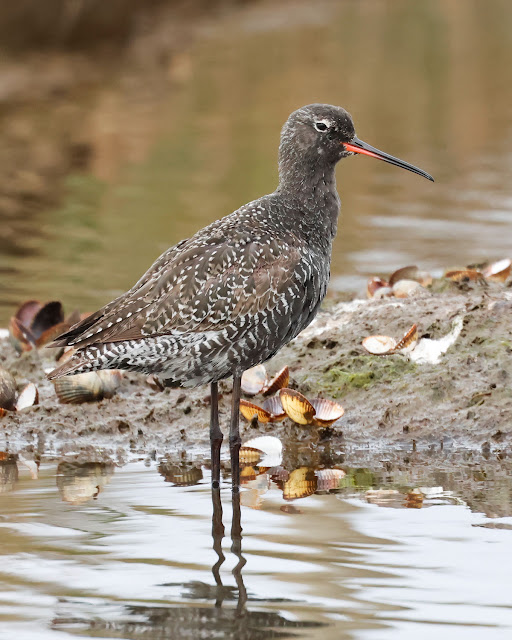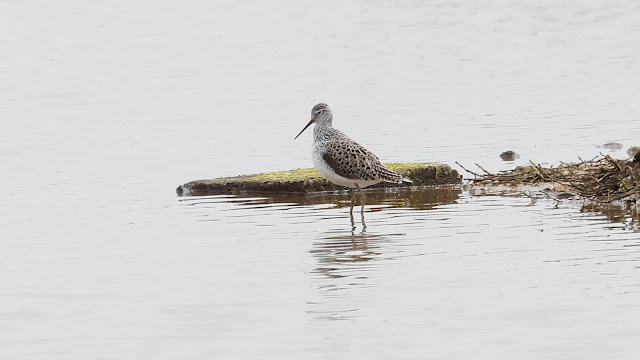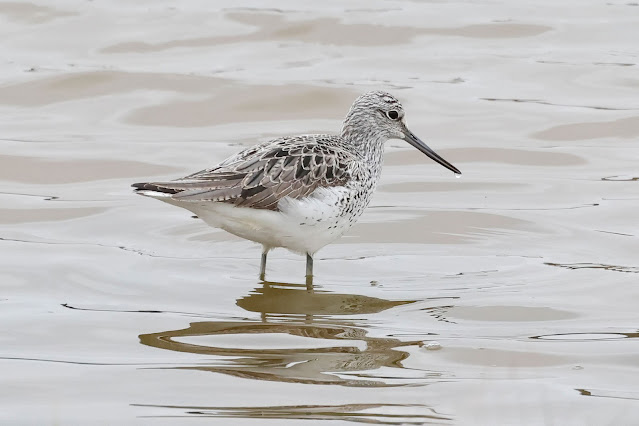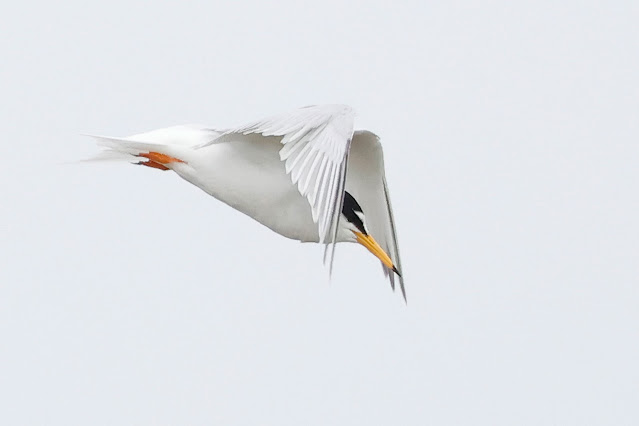Last weekend Ian and I made the decision not to go chasing the Marsh Sandpiper found on Normandy Marsh. We anticipated it would be very busy, which it turns out it was, and we felyt it would probably stick around for a few more days. This of course was a risk, but when I got up the Marsh Sandpiper had already been reported from Normandy Marsh, so I set off without having to get up at silly o'clock.
I decided to park at the bottom of Lower Woodside and was pleased to find there was plenty of space. I made sure this time the car was all locked up and set off around Oxey Creek to Salterns. Making my way along the sea wall from the dock there was a pair of Avocet feeding on the far side of the lagoon, while in the north east corner I noticed a wader dip feeding. Getting closer I could see it was a Spotted Redshank and in full summer plumage, something really special.
With it being overcast, the water was a pale grey and contrasted the dark plumage of the Spotted Redshank well. It was preening.
One of the most elegant waders, with its slim proportions
and long needle-like bill, the Spotted Redshank lives up to its name when in
its summer plumage, which is dark with white spots.
I dropped down from the sea wall and was able to approach and photograph at eye level, the spot-shank moved but not too far away.
Spotted Redshank does not breed in Britain and is mainly a
passage migrant, seen in both spring and autumn. Unlike the dark summer
plumage, autumn and winter individuals are grey above and white below, much
paler than their more uniform common cousin, the Redshank.
There is an increasing wintering population in England, with
birds distributed mainly around the eastern and southern coasts. Here at the Keyhaven - Lymington Reserve is one of the more favoured spots on the south coasts, I have seen up to six birds here at one time during the winter.
It was happy for me to slowly edge closer.
This was the last shot before it was flushed by another considerate dog walker!
I walked on around the eight acres pond and then on to Normandy. There was a collection of birders on the sea wall at the west end so I was confident the sandpiper was there and as I reached the spot I could see it feeding in the lagoon.
It was though, distant, but it was still possible to pick out the straight thin needle like bill which differs from the similar Greenshank's much more bulky bill.
It stayed away at distance and I waited to see if it would come closer but instead it flew to the back of the pool to chase a Redshank away. I decided after a while to move on and come back later when hopefully it would come closer.
I walked to the south side of the marsh and was treated to some Little Terns fishing.
Recently arrived, there was around sixteen birds present around the area.
The hover followed by the dive.
There were also Common Terns about, here like the Little Terns hovering before diving for their dinner.
There were plenty of Avocet, many paired up and either feeding together or roosting, which provided some lovely reflections.
I love Avocets in black and white images.
I was alerted to a group of seven Bar-tailed Godwits on the east side of the lagoon, several in full breeding plumage. I made my way around and found them feeding quite close to the sea wall.
A colour ringed bird that was ringed in the Netherlands.
In breeding plumage the Bar-tailed Godwit is easy to separate from the Black-tailed Godwits, the brick red plumage covering the chest and belly, while the Black-tailed has a pale belly.
The bill is also shorter and more upturned, the legs shorter and the bird overall slightly smaller than the Black-tailed Godwit.
Here one in non-breeding plumage.
Then two other joined the fully plumaged bird, these were still in moult, developing the breeding plumage.
It was time to walk back to see if the Marsh Sandpiper was being more obliging, however I stopped on the way to photograph a Greenshank, this would provide a good comparison.
Here you can see the bulkier bill of the Greenshank.
Seven Little Terns on one of the islands.
The Marsh Sandpiper was still at the far side of the pool.
It then started to make its way towards me on the sea wall, feeding in a manner very similar to the greenshank.
The overcast and still conditions providing some lovely reflection in the water.
As mentioned, the Marsh Sandpiper resembles a small, elegant
Greenshank, with a long fine bill and very long yellowish legs. Like the
greenshank, it is greyish brown in breeding plumage, seen here, paler in
winter, and has a white wedge up its back that is visible in flight. However,
it is more closely related to the Common Redshank and the Wood Sandpiper.
It is a rare visitor to the United Kingdom and even rarer in Hampshire, this being the sixth bird only since 1976.
It walked ever closer, reflecting in the still water.
The marsh sandpiper breeds in the Palearctic. It is a
migratory species, with a majority of birds wintering in Africa and India,
and some migrating to Southeast Asia and Australia. They prefer
to winter on freshwater wetlands such as swamps and lakes and are
usually seen singly or in small groups.
The Latin name for the marsh Sandpiper is Tringa Stagnatilus. Tringa refers to the Green Sandpiper a similar wader and Stagnatilus meaning "swamp", the habitat they are found in.
This is one of my favourite images.
While this wasn't a life tick for me, I have seen them in Sri Lanka, India and Africa, it was a first for the UK and of course Hampshire.
It was a case of make the most of it, you don't know when there will be another.
Finally two wonderful images with superb reflections.
It made its way back across the pool and away from me, with a considerable number of images I was satisfied with my encounter with this elegant wader.
A Curlew Sandpiper had been reported and I was hoping for a nice summer plumaged individual, however it turned out to only have a little ping on the breast. No problem, a nice find in April.
I wanted to get some more shots of the terns around the lagoon, so walked back to the south side of the sea wall.
Walking around there was a Black-tailed Godwit at rest, note the pale belly and more orangey red plumage cover.
And more Avocet reflections.
The terns were performing, first the Common Terns.
Then the smaller Little Tern as the name suggests.
In flight their wing beats remind me of Bats.
Rain had been threatening all morning, but as we approached 13:00 it was just starting, I decided to walk back to the car, but when I got there the light rain eased so I decided to walk on to Pennington. Out over the marsh were quite a few Swallows and in the middle of the flooded area a single Spoonbill.
The rain picked up once again and I decided to make my way back. I did though stop for this drake Tufted Duck on the lake by the footpath.
A very successful four hours and worth the journey.

















































































No comments:
Post a Comment